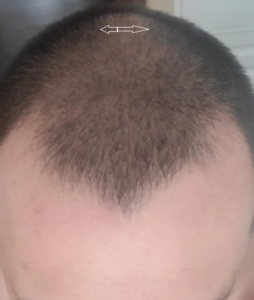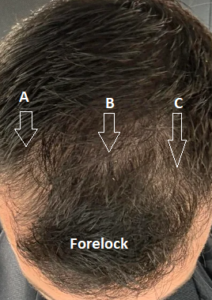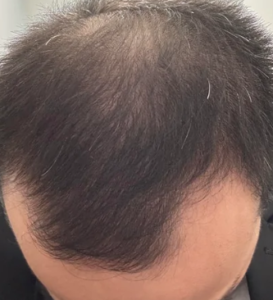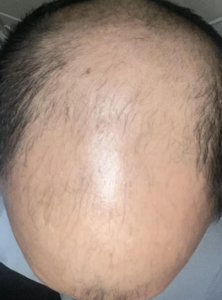I’m one of the countless who have started taking Dut and trying to figure out the best way to transition off of Finasteride to Dut daily. It seems that doctors and users do not agree on this topic. Some have suggested, and it seems in theory, that taking a loading phase of Dut is the best route since it takes 3 months of 0.5mg to reach steady state serum levels and possibly more at the tissue level. My current routine went from 1mg Fin to 0.5mg finasteride daily and 0.5mg Dutasteride daily. In theory, I’d do this for 3 months to not cause a shed from a medication gap, switch cold turkey, minimize simultaneous new medication shed, and stop fin shed. Since Fin binds to androgen receptors at the tissue level (scalp), and if finasteride is already binding to it all before dutasteride is introduced, does that prevent dutasteride from being able to bind to those receptors? And is it probably better to discontinue Fin and just keep doing dutasteride? People have great results when adding dutasteride 1x or 2x a week, which sounds counterproductive. In theory, thought would still leave Duta to block type 1 receptors, but fin still blocking type 2? I’ve seen, admittedly, just a few horror stories when people go up to 3x a week while using finasteride. They get better results once they go all in on one or the other. As much as I researched this, I’m still ignorant of how these drugs work at this level since most talk about its DHT blocking is usually blood /serum DHT and not at the scalp/tissue level.
First, you’ll need the doctor to evaluate your donor area to rule out any disease that may be there. Assuming that you are over 25, the pattern looks like you are going to a Class 5A pattern. I would need to see your hair under trichoscopy to determine that, but it means that more balding is likely to occur on a limited basis in your upper crown areas. Good doctors routinely perform trichoscopy to rule out diseases of the donor area and the metrics that I am about to discuss. It would be best to have metrics for your lifetime donor supply, including (1) donor density and (2) hair shaft thickness of the donor hairs. This will tell the surgeon what you will look like after the hair transplant, which will be shared with you. Then, a good surgeon will complete the examination by judging where your balding pattern will end up. Good planning is critical so you only expend some of your donor hair on a limited vision of where you are now. Balding is progressive, and you want to be sure that in the long term, you will always look normal and have enough hair left to follow the progressive nature of YOUR balding.
Hi! I was stupid and stopped fin for a couple of month due to travelling at that point my hair was great and after I realized what I had done, I went immediately back of 0.5mfs every other day but my hair went absolutely bad and shedded for two more months. I’m devastated right now.
When you get benefits from finasteride, you must remember that the drug and your stabilized hair loss go hand in hand. Stopping finasteride causes “Catch-up Hair Loss” which means that when you stop the finasteride, you not only go back to where you were when you started taking it, but you lose what you would have lost had you not taken it in the first place. Please, if you are on finasteride and you are not having problems with the drug, stay on it.
Some men have strong forelocks; when they start balding, as this man shows, you see the forelocks remain strong. The balding occurs around the forelock (A, B, C). A man with a strong forelock often doesn’t look like they are balding because the forelock holds the frame to the face. When I transplant balding in a patient with the pattern shown below, I leave the forelock alone, realizing that sometimes, as this man grows older, he may lose the forelock, and then he will need it transplanted; however, in my experience, when men have strong forelocks to the age of 35, they are more prone to keep these forelock, regardless of the balding that may occur over time further back in the head. These forelocks, I believe, have a genetic code different from the surrounding hair.
Any idea if ursolic acid can help with male-pattern hair loss? In the study below, it says it reduced DHT.
Ursolic acid appears to be an interesting possible treatment for a variety of conditions including an enlarged prostate, inflammatory diseases and some cancers however it is not approved for clinical use. Although it is easy to extrapolate its effects on prostate hypertrophy and its relationship to hair loss, there is no proof that this has value nor that it is safe for the treatment of hair loss.
21 y/o, been on fin for 3 months now and am seeing some new strands around the temples I think, but as the recession is already so big I wonder if it will be enough in my case. But topical min is ofc rather inconvenient (is it even sustainable long term..?), and oral min is not available where I live.
What do you think – is it worth giving fin alone a couple of more months or is it unrealistic to get this amount of regrowth with fin? After summer I will move to a new city so I definitely want to look better by then.
I have seen men who lost hair regain their hair on finasteride alone. They are usually under 24 years of age and they looked like they never were balding.
I’ve heard mixed things on this. Some doctors have said that it can cause micro-scarring and make the scalp not viable for a transplant. If that’s the case I might want to stop. Generally I do like 1mm dermastamp once weekly.
Microneedling done at a 1.25mgg depth doesn’t go deep enough to cause significant scarring. On average, the hair follicle goes down to a depth of between 5-7 mm, so the growth of the hair follicle in the dermis is unobstructed by any scarring.
I unable to find 1Mg finasteride and there is only 5Mg available in my country .. what to do please help??
This is not uncommon. I advise people to cut the pill into 4 or 5 equal parts. Most people find that the pill will crumble so apportion the amount that you take. It is important to know that what counts is not the daily dosage but the weekly dosage divided into seven days.
Hey all, I am soon going to start using topical minoxidil. The only brand (Linn Minoxidil) I could get a hold of somewhat easily where I live (the Netherlands) is a spray. The manual says to spray six times on the balding spot. But I am a norwood 3.5-4, and hence would like to spray both on my diffusing crown and receded temples. The manual however does not specify how to treat multiple areas, i.e do I just do three sprays on the temple and three sprays on the crown? Or do I have to use the spray on i.e the crown alone? Was wondering if anyone here has faced this issue/knows the answer.
First, you must be aware that only 40 % of men will respond to the topical minoxidil. On the other hand, the oral form is 100% effective because it is metabolized in the liver into its active form. I generally prefer to agree with the manufacturing instructions; however, with the topical minoxidil that I am familiar with, one good application a day works well. I recommend applying it after a hot shower on a damp scalp to increase absorption. If you do not get a good response to the topical, you may assume that you are one of the 60 % of men who do not respond to the topical form. If you are committed to going the minoxidil route, the oral form requires a prescription. I have seen wonderful results from oral minoxidil.
When you bleed with microneedling, it shows you are at the correct depth. From a numbers perspective, I recommend a 1.25 mm depth. I particularly like the “Dr Pen” device because you can hold it over each area and deliver an effective injury to induce the healing cascade. Once per week is adequate; more frequent use is unnecessary. The photograph shows that you are using it where you want your hairline to return. I can see that clearly by the bleeding that shows in the photo.
I have a question regarding the mechanism of action behind androgenetic alopecia. I see some people saying that we lose hair as males with pattern hair loss because the scalp hairs are more sensitive to DHT in the area of balding (pattern). I also read that some people say that the conversion from test to DHT (via. 5AR) is greater in the scalp tissue than in other body parts. This begs the question: why would you ever need to block DHT in the whole body by using oral meds like fin and dut If the “problematic” test conversion happens in the scalp tissue, then topical dut/fin or a topical anti-androgen should be enough ? Anything I am missing something? Thank you!
Hair loss occurs in males because we carry the genes for hair loss, and our DHT hormones trigger hair loss. The genes are programmed to determine when hair loss starts, but most men get it before age 26. I have seen men develop hair loss as late as in their early 50s, but this is an exception to the rule. If we decided to cut off your testicles, I doubt that you would have hair loss, but that is an extreme approach to reduce the impact of DHT. Topical finasteride goes through the skin and into your body as it gets absorbed through the skin/scalp. You might as well take the oral finasteride. There is a type of liposomal topical finasteride where most of it stays in the scalp, but this is expensive and only covers part of the scalp. If you spread it around the scalp, it raises the cost considerably.
I’m cautious of the microneedling + Minoxidil success stories here only because it might be the case that they were strong responders to Minoxidil irrespective of the microneedling. I’m more interested in those who added microneedling to the protocol after some time on Minoxidil/min+fin alone. Anyone with some post history or experiences?
Microneedling will work by itself without minoxidil.
I have been applying minox foam to my pubic hair for the past 3 months. My pubic hair was quite long to begin with, but now the hairs are over 4 inches long. Typically they would be only at 2-3 inches at the longest. I was doing this experiment to see if it would make sense to use pubic hair in a hair transplant and my research has lead me to believe minox is a valid solution to the length issue when using pubic hair for scalp hair transplant. I will continue to apply once a day, 1 ml for the foreseeable future (wife is not happy)
Pubic hair has been used for hair transplants in the past. The problem is its very curly nature and it may not match your hair characteristics.
I was quoted 3200 grafts- 2500 for hairline and 800 for crown and midscalp. Clinic told me it was a conservative estimate as I indicated I would still be on meds for another 5 months before doing the HT (been on fin / minox for the past 7 months). Do you think this is a fair estimate? I’m not hopeful of regrowing more hair from meds as progress from meds seems to be quite stagnant past the 5-month mark for me. Would appreciate your thoughts!
What is your age? If you are under 25, reconsider doing a hair transplant. It takes a year to see results from medications. 2500 grafts for the frontal hairline? As I can’t see your hairline, I would be just guessing that it seems high. The crown will likely reverse with finasteride and minoxidil, and certainly, if you add microneedling. You should get results in 9 months or less from this routine. You need to get a competent and hopefully honest surgeon and not blow your future on numbers that make no sense. You would likely lose all of the hair that is there now if there is any significant degree of miniaturization and if you don’t take finasteride.
You need your donor density and donor hair mass measured to find out if you are a suitable candidate and what you can expect. Make sure that you get numbers from your doctor as this is mathematically based. I have answered this question many times, so read many of my answers here: https://baldingblog.com/?s=how+many+grafts
There is a misconception that many patients and surgeons that they must replace the recipient area density in the balding area when having a hair transplant. Nothing could be further from the truth. Too many Reddit patients are wasting their donor supply by using too many grafts to cover Class 3 or 4 patterns of balding. Too many Reddit patients do not seek a Personalized Master Plan ((https://baldingblog.com/creating-a-personalized-master-plan-for-present-and-future-balding) with their surgeon before they embark on a hair transplant in Turkey or elsewhere. First, look at the analogy and the following numbers: Assuming a surgeon removed 12,500 grafts from the donor area in a Class 7 patterned patient. The average man has 50,000 follicular units (grafts) on his head (race in not dependent upon this number) of which 12,500 grafts reflect the donor area (12,500 grafts reflect 25% of the total follicular units). The total donor supply equals 25% of the total hair supply. This means that if the surgeons did only FUE and transplanted 12,500 grafts in the recipient area, there would be nothing left in the donor area. In such a surgery, the patient would likely become either bald in the donor area or heavily overharvested in the donor area if partial follicular units were excised rather than full FUe grafts. This patient would have a new problem: a bald donor area. His recipient area density would not exceed 30% of the original recipient donor density. With too many grafts removed from the donor area, there is no going back after this is done. Even transplanted numbers of 5000, 6000, or 7000 grafts reported by many Reddit patients reflect the maximum yield of their donor area if they have fine or possibly medium-weight hair. They may end up with a see-through donor area for their entire lives. Many of these Class 3, 4, or 5 balding patterns may leave very few grafts left in the donor area to address almost certain future balding because hair loss is ALWAYS progressive. When I review Reddit’s transplanted patient posts, I often see too many grafts for a particular balding pattern, reflecting poor planning and an impulse surgery decision in men who are often too young.
Transplanting into the recipient area is not blindly removing as many grafts as possible and moving them into the recipient area. An experienced, well-trained hair transplant surgeon, with proper knowledge of both the original donor density and hair mass of the patient’s donor area, can make proper artistic and mathematical calculations to obtain good results with less than the original recipient area density achieved. I have done this thousands of times on very bald men, even those in patients with a Class 6 or 7 pattern of balding, and I have never removed a total of 12,500 grafts. I have had thousands of satisfied patients over my 33-year career. I suggest that many of you review Dr. Linkov’s interview with me, which covers much of the history of botched hair transplants, even on celebrities such as Frank Sinatra. Here is the podcast link: https://baldingblog.com/dr-gary-linkov-blog-features-william-rassman/
When I transplant a Class 4A pattern balding patient, I often try to get frontal densities in the 35-40% range for the first 1 inch of hairline; then, I reduce the density I create. If the man has a particular hairstyle they like (for example, combing their hair left to right with a part on the left side), I would place a disproportional number of grafts on the parted side to enhance his styling and achieve a fuller look and save donor hairs on the opposite side. For the very bald man, such discussions with their surgeon are critical, as their donor supply may only be able to supply the needed hair to achieve a full-looking head of hair, only, if proper planning is done in advance.
Yesterday, I met with a patient I had transplanted twice over 1 year, the last surgery just 8 months ago. He had a Class 6 balding pattern and a very poor donor supply, needing more hair to get to a full-looking head of hair than he had. To substitute for his lack of donor hair, I used beard hair for the top and mixed the beard hair with the hair I got out of his donor supply. The result was amazing. Such meetings make my day.
FYI: STATEMENT: 50% of recipient area density in a man with black hair and white skin is as good as 100% recipient area density. That observation is even more favorable as the skin becomes darker and the hair becomes lighter, or the hair and skin color match. HOW THIS WAS DETERMINED: This was demonstrated by Dr. Manny Marrit some years ago when he plucked out 50% of the hairs on one side of the head of a man with medium-weight hair, which was black, and his skin was white. No one could tell the plucked side from the Non-pucked side.)





